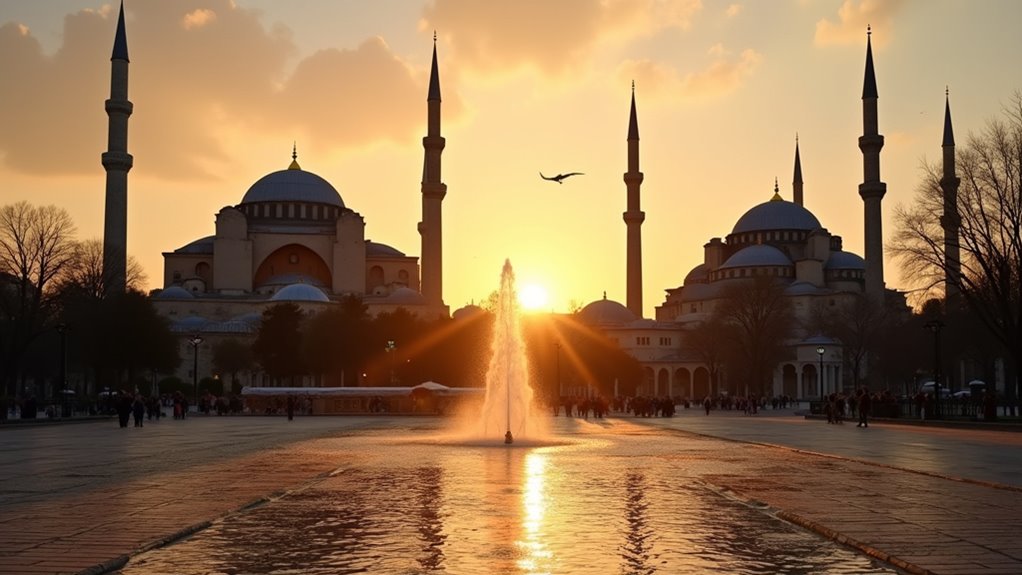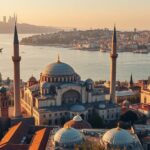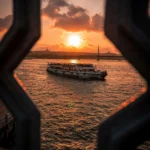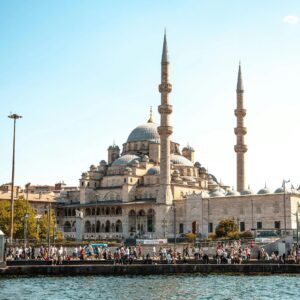By sheer coincidence, Hagia Sophia & Blue Mosque stand just minutes apart in Istanbul’s Sultanahmet Square, yet they represent distinct eras of architectural brilliance. Hagia Sophia, with its groundbreaking dome and shimmering Byzantine mosaics, later transformed into a mosque, showcases a fusion of Christian and Islamic artistry. Meanwhile, the Blue Mosque dazzles with its six slender minarets and intricate blue Iznik tiles, embodying Ottoman grandeur. Together, they offer an enthralling journey through time—but their contrasts reveal even more surprises.
Exploring Hagia Sophia’s Architectural Wonders
Exploring Hagia Sophia’s Architectural Wonders is like stepping into a living chronicle of empires. Though it has stood for nearly 1,500 years, its architectural brilliance continues to captivate, a breathtaking testament to human ingenuity and spiritual devotion.
Located majestically in the heart of Sultanahmet Square, this monumental structure effortlessly blends the awe-inspiring grandeur of Byzantine architecture with the elegant influences of later Islamic artistry, firmly ranking among Istanbul’s most iconic landmarks and pivotal historical sites.
At its core lies the colossal central dome, a marvel that revolutionized Byzantine engineering and architectural thought. Soaring almost 56 meters high, it was an unprecedented feat for its time, creating a vast, column-free interior space that seems to float effortlessly, bathed in ethereal light pouring through its ring of windows.
Inside, visitors are truly dazzled by a symphony of design: intricate mosaics depicting Christian emperors and religious scenes shimmer alongside colossal Ottoman-era calligraphic roundels, their gold leaf declaring verses from the Quran. Towering columns of porphyry and verd antique marble rise to support majestic arches, framing sweeping galleries that offer different perspectives of this vast sacred space.
Originally constructed in the 6th century as the patriarchial cathedral of Constantinople, Hagia Sophia later became one of Istanbul’s most revered mosques following the Ottoman conquest in 1453. This transformation brought significant Islamic additions, including the four towering minarets that pierce the sky, a beautiful mihrab (prayer niche) oriented towards Mecca, and an ornate minbar (pulpit). These elements were not simply overlaid but integrated, creating a unique synthesis of two great civilizations and faiths within a single structure.
Its rich and layered history as a continuous center of worship and culture profoundly underscores its significance in Istanbul’s cultural heritage. Today, Hagia Sophia remains a powerful reflection of the city’s complex, intertwined past, continually drawing millions from across the globe to marvel at its timeless beauty, profound architectural innovation, and the compelling narratives etched into every stone and mosaic.
Discovering the Blue Mosque’s Ottoman Splendor
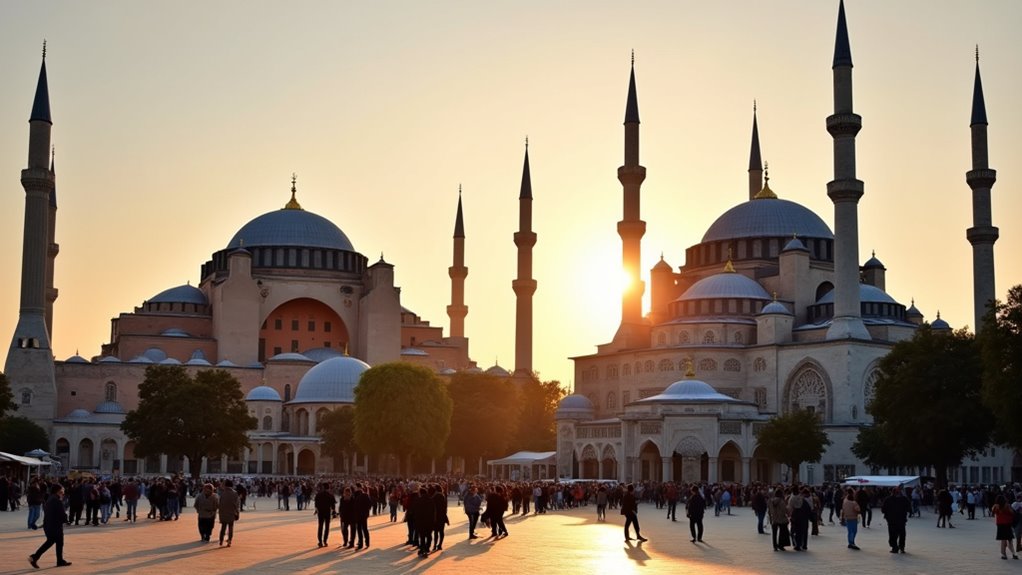
Just steps away from Hagia Sophia, the Blue Mosque, formally known as the Sultan Ahmed Mosque, stands as a breathtaking example of Ottoman-era architecture. Built between 1609 and 1616 during the reign of Sultan Ahmed I, this iconic structure showcases the unparalleled grandeur of Istanbul’s religious sites with its distinctive silhouette against the sky. Its majestic form features a harmonious cascade of domes, culminating in a grand central dome, flanked by an unprecedented six slender minarets that elegantly pierce the heavens.
Stepping inside, the interior truly dazzles, living up to its famous moniker. Over 20,000 hand-painted blue Iznik tiles adorn its walls, creating a mesmerizing tapestry of intricate floral patterns, geometric designs, and calligraphy that shifts with the light.
These exquisite tiles, bathed in natural light filtering through more than 200 stained-glass windows, imbue the mosque with its serene, ethereal blue glow. Grand carpets cover the vast prayer hall, enhancing its profound sense of tranquility and spiritual reverence.
For visitors on Istanbul private tours or Istanbul guided tours, the Blue Mosque is an absolute highlight, often included as part of a dual masterpiece tour with Hagia Sophia to fully appreciate its intricate craftsmanship, profound historical depth, and the striking contrast in architectural styles.
Here’s why the Blue Mosque is an essential experience:
- Architectural Grandeur: A masterpiece of classical Ottoman design, showcasing cascading domes and an elegant courtyard.
- Six Soaring Minarets: Uniquely distinguished by its six slender minarets, a rare feature in mosque architecture.
- Iznik Tile Brilliance: Its interior is adorned with over 20,000 hand-painted blue Iznik tiles, giving the mosque its iconic name and ethereal glow.
- Spiritual Oasis: A still-active place of worship that offers a profound sense of peace and historical continuity.
- Historical Significance: Reflects the spiritual and artistic zenith of the Ottoman Empire during Sultan Ahmed I’s reign.
A cornerstone of Istanbul history and a vibrant hub of devotion, the Blue Mosque beautifully encapsulates the spiritual and artistic zenith of the Ottoman Empire, making it an absolute must-see for anyone exploring Istanbul’s rich cultural and architectural heritage.
Essential Tips for Visiting Both Landmarks

When planning your visit to two of Istanbul’s most magnificent landmarks, Hagia Sophia and the Blue Mosque, a little preparation goes a long way. Prioritizing timing, understanding the dress code, and being mindful of cultural sensitivities are key to fully appreciating these architectural marvels and ensuring a smooth, enriching experience.
Arriving early in the morning, right at opening, or later in the afternoon can significantly enhance your visit, guaranteeing fewer crowds and smoother access. This is especially true as both sites have specific visiting hours and, for Hagia Sophia, there is an entrance fee.
Given that both are best explored on foot, comfortable footwear is absolutely essential for your Istanbul walking tour between them and within their vast interiors. Respecting the Istanbul mosque dress code is paramount for uninterrupted access and demonstrates deep cultural sensitivity.
Combining these two masterpieces into a single Istanbul architecture tour offers a truly unparalleled experience, allowing you to observe their fascinating historical and artistic contrasts firsthand—from Hagia Sophia’s ancient Byzantine mosaics and soaring dome to the Blue Mosque’s intricate Ottoman tiles and elegant minarets. Proper planning ensures you can immerse yourself fully in Istanbul’s rich heritage and capture stunning, crowd-free photographs.
Here are some essential tips for a seamless visit:
| Category | Hagia Sophia (Grand Mosque) | Blue Mosque (Sultan Ahmed Mosque) |
| Best Time to Visit | Early morning (9-10 AM) or late afternoon (4-6 PM) to avoid peak crowds and enjoy softer light. | Early morning or late afternoon, checking prayer times beforehand (especially avoid Friday noon prayers). |
| Dress Code | Men: Knees and shoulders must be covered. Women: Knees, shoulders, and head must be covered. Headscarves are often provided at the entrance if needed. | Men: Knees and shoulders must be covered. Women: Knees, shoulders, and head must be covered. Headscarves are often provided at the entrance if needed. |
| Entrance | Requires a paid entrance fee (please check the official Turkish Ministry of Culture and Tourism website for current pricing). No entrance during prayer times. | Free entrance. Closed to visitors during the five daily prayer times (approx. 90 minutes each). |
| Key Etiquette | Maintain respectful silence, avoid loud conversations, and refrain from flash photography, especially towards worshippers. | Maintain respectful silence, remove your shoes upon entry (bags are provided for carrying them), and refrain from flash photography. |
| Footwear | Comfortable shoes are highly recommended for exploring the vast interior and the surrounding historical complex. | Comfortable shoes are essential, as you will be removing them before entering the prayer hall. |
Dress Code and Visitor Etiquette for Mosques
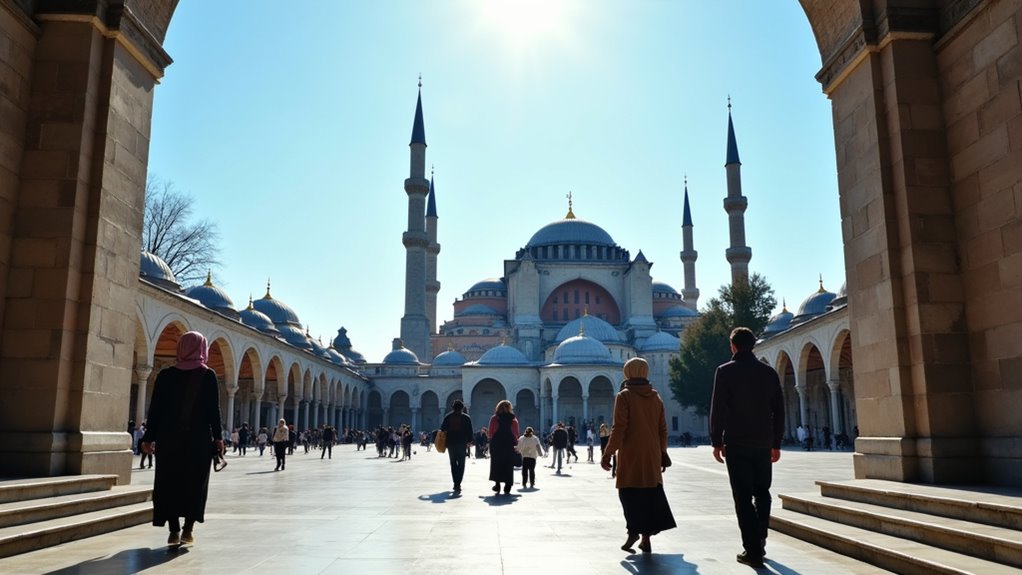
Respecting the sacred atmosphere of Istanbul’s magnificent mosques is not just a courtesy; it’s an essential part of truly experiencing their profound spiritual and historical significance. Adherence to specific dress codes and visitor etiquette guarantees both your cultural sensitivity and uninterrupted access to these breathtaking architectural wonders.
As key features of ancient Istanbul and its rich heritage, the Aya Sofya (Hagia Sophia) and the Sultan Ahmed Mosque (Blue Mosque) stand as Istanbul’s absolute must-see attractions, drawing millions to their iconic domes and minarets.
When entering these revered sites, visitors are asked to observe simple yet vital guidelines:
- For women: It is essential to cover your head, shoulders, and knees.
- For men: Please ensure your shoulders and knees are also covered.
Don’t worry if you come unprepared; both mosques are accustomed to visitors and often provide scarves for head coverings and wraps for legs at their entrances, emphasizing comfort alongside respect.
Beyond attire, mindful conduct within these sacred spaces is crucial:
- Maintain a respectful quiet: Speak in hushed tones, if at all, to preserve the tranquil atmosphere.
- Avoid photography during prayers: Be particularly aware of prayer times when visiting, and refrain from taking photos that might disturb worshippers.
- Remove your shoes: This is a fundamental sign of respect when stepping onto the carpeted prayer areas. Designated shoe racks or plastic bags are typically provided.
These practices are not merely rules; they are an invitation to honor the spiritual essence of these architectural masterpieces, enriching any Istanbul city tour with a deeper appreciation for their profound cultural and historical significance.
As the great philosopher Rumi once said,
“Come, come, whoever you are… Our caravan is not of despair. Come, even if you have broken your vows a thousand times. Come, yet again, come.”
This sentiment of welcoming respect resonates deeply within these walls. By observing these simple acts of reverence, you’ll not only ensure a seamless visit but also connect on a more profound level with the timeless spirit of Istanbul.
Planning Your Unforgettable Dual Masterpiece Tour
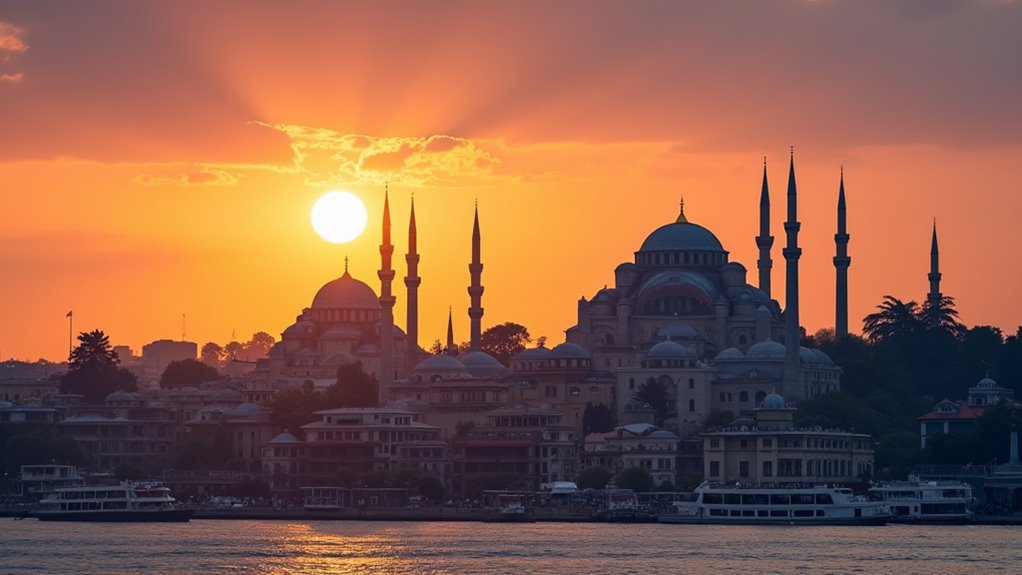
Embarking on a combined tour of Hagia Sophia and the Blue Mosque isn’t just seeing two of Istanbul’s most iconic landmarks; it’s an immersive journey through centuries of history, faith, and breathtaking architectural brilliance. This isn’t just a sightseeing trip; it’s an opportunity to truly feel the pulse of a city that has gracefully blended empires and cultures.
Imagine beginning your exploration within the awe-inspiring vastness of Hagia Sophia. Here, you’ll stand beneath its legendary dome, marveling at the layers of Byzantine mosaics and Ottoman calligraphy that whisper tales of emperors, sultans, and profound spiritual transitions.
From there, a mere stroll across the vibrant Sultanahmet Square transports you to the serene elegance of the Blue Mosque. Its name comes to life as you step inside, surrounded by thousands of shimmering blue Iznik tiles and the peaceful grandeur of its cascading domes.
To truly maximize your experience and capture those perfect, crowd-free moments, a little smart planning goes a long way. Aim to arrive early in the morning or later in the afternoon. And remember, both are active places of worship, so respecting their prayer times and adhering to the shared dress code ensures a smooth and deeply respectful visit.
This dual masterpiece tour, set against Istanbul’s vibrant skyline, offers more than just stunning visuals. It’s a reflection of the city’s rich cultural and religious heritage laid bare, inviting you to witness the seamless intertwining of history, art, and devotion. It’s an experience that won’t just fill your camera roll, but also your soul.
Frequently Asked Questions
Can I Take Photos Inside Hagia Sophia and the Blue Mosque?
Visitors may capture memories through photography inside Hagia Sophia and the Blue Mosque, ensuring they respect the sanctity of these sacred spaces. Flash photography’s discouraged, and visitors should avoid taking photos during prayer times.
Are There Separate Entrances for Men and Women?
Separate entrances for men and women aren’t enforced at Hagia Sophia or the Blue Mosque. Both mosques require modest dress and head coverings for women, but visitors enter through shared entrances without gender segregation.
Are Strollers Allowed Inside the Mosques?
For families with young children, strollers typically aren’t permitted inside mosques to preserve the tranquility and sacred space. Visitors often find designated areas nearby to leave strollers while exploring these cherished spiritual sites.
Can I Visit if I’M Not Religious?
Non-religious visitors can explore both mosques, as they’re open to all respecting the dress code and visiting hours. Hagia Sophia and the Blue Mosque welcome guests regardless of faith, offering insights into their historical and cultural significance.
Are Guided Tours Available in Multiple Languages?
Guided tours often cater to diverse visitors by offering multiple languages. English, Spanish, German, and French are commonly available, ensuring travelers grasp the rich history without language barriers. Some operators even provide rare language options upon request.


